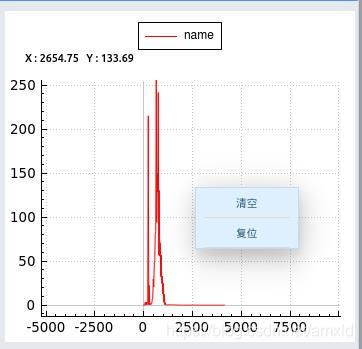QT-QCustomplot实现左键拖动、右键框选、滚轮缩放与菜单选项
本文主要为了实现QCustomPlot的鼠标键盘事件
首先你需要已经下载到QcustomPlot所需的文件,这里不多做介绍,网上很多。
qchart也有一个版本。需要请转到https://blog.csdn.net/amxld/article/details/112987703
主要任务
1:鼠标左键拖动
2:鼠标右键框选能够显示框选的部分
3:滚轮能够放大缩小图像
4:鼠标单击右键可以显示菜单 功能:清空,复位
5:图像上发显示当前坐标并且保留两位小数
6:在图像正上方加入曲线的标签(默认是在图像右上角,操作比较麻烦需要自己调节位置)
下面是效果图
下面直接进入代码吧!
头文件函数定义:
class MyCustomplot : public QCustomPlot
{
Q_OBJECT
public:
explicit MyCustomplot(QWidget *parent = 0);
~MyCustomplot();
void setZoomMode(bool mode);
public slots:
void setPlotData(const QVector<float> plots,QString lineName);
protected:
void mousePressEvent(QMouseEvent * event);
void mouseMoveEvent(QMouseEvent * event);
void mouseReleaseEvent(QMouseEvent * event);
protected slots:
void OnResetAction();
void OnClearAction();
private:
int m_graphIndex;
bool mZoomMode;
bool m_isMove;
QRubberBand * mRubberBand;
double m_minX,m_maxX,m_minY,m_maxY;
QCPRange m_Xaxis,m_Yaxis;
QPoint mOrigin;
QLabel *m_lbxy;
};
具体实现:
#include "mycustomplot.h"
#include "ui_mycustomplot.h"
#include 代码就这些,可以试下有问题可以评论联系我。
QT4/5都可以使用,虽然没有Qchart方便好看,但是在QT4完美运行。
qchart也有一个版本。需要请转到https://blog.csdn.net/amxld/article/details/112987703
